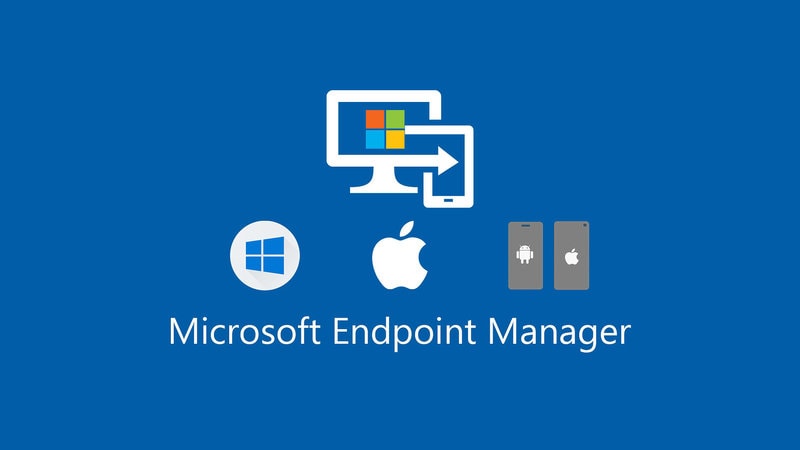Why Is Microsoft Endpoint Manager Essential For Device Management?

Microsoft Endpoint Manager is a crucial tool for effective device management in today’s digital landscape. With the proliferation of devices and the increasing complexity of IT environments, organizations need a unified solution that can streamline device management processes. This article explores why Microsoft Endpoint Manager is essential for device management by examining its key features and benefits.
One of the primary advantages of Microsoft Endpoint Manager is its ability to provide unified device management. By bringing together multiple device management tools into a single platform, organizations can simplify and streamline their management processes.
Additionally, Microsoft Endpoint Manager seamlessly integrates with other Microsoft services, allowing for a cohesive and interconnected IT ecosystem.
Moreover, Microsoft Endpoint Manager offers comprehensive security features, ensuring that devices are protected against potential threats and vulnerabilities. This includes automated patching and updates, which help to keep devices up to date and secure.
Furthermore, Microsoft Endpoint Manager enables remote device management, allowing IT administrators to manage devices from anywhere, at any time. This flexibility enhances productivity and efficiency by reducing the need for on-site management.
Additionally, the application management and distribution capabilities of Microsoft Endpoint Manager simplify the deployment and management of software applications across devices. This feature saves time and enhances user experience.
Furthermore, Microsoft Endpoint Manager provides robust reporting and analytics features, allowing organizations to gain valuable insights into their device management processes and make data-driven decisions.
Lastly, Microsoft Endpoint Manager offers significant cost and time savings by consolidating device management tools and streamlining processes. This not only reduces overhead costs but also frees up IT resources to focus on more strategic initiatives.
In conclusion, Microsoft Endpoint Manager is an essential tool for device management due to its unified device management capabilities, seamless integration with Microsoft services, comprehensive security features, remote device management capabilities, application management and distribution capabilities, reporting and analytics features, and cost and time savings benefits.
Key Takeaways
- Unified device management: Microsoft Endpoint Manager brings together multiple device management tools into a single platform, allowing for efficient and streamlined device management.
- Seamless integration with Microsoft services: It integrates seamlessly with other Microsoft services such as Azure Active Directory, Microsoft Intune, and Office 365, providing a cohesive and interconnected IT ecosystem.
- Comprehensive security features: Microsoft Endpoint Manager offers robust security features including automated patching and updates, advanced threat analytics, and proactive monitoring capabilities, ensuring the security and compliance of devices.
- Remote device management: It enables administrators to remotely monitor, control, and troubleshoot devices, allowing for remote software installations, updates, and configurations without physical access to devices. This enhances productivity and efficiency.
Unified Device Management
Unified Device Management is a critical aspect of Microsoft Endpoint Manager as it enables organizations to efficiently and securely manage all their devices, regardless of the operating system or location, from a single centralized platform.
With the increasing diversity of devices used within organizations, ranging from Windows PCs to Macs, iOS, and Android devices, it has become essential to have a unified solution that can handle the management of all these devices.
Microsoft Endpoint Manager provides a comprehensive set of tools and capabilities to streamline device management processes, including device enrollment, configuration management, policy enforcement, application deployment, and security monitoring.
This unified approach eliminates the need for multiple management solutions, reduces complexity, and enhances efficiency. Furthermore, organizations can enforce security policies consistently across all devices, ensuring data protection and minimizing security risks.
By providing a unified device management solution, Microsoft Endpoint Manager simplifies the management of devices and enhances productivity within organizations.
Seamless Integration with Microsoft Services
Integrating seamlessly with various services offered by the software giant, this device management solution enhances operational efficiency and streamlines the management of diverse endpoints.
Microsoft Endpoint Manager provides organizations with a comprehensive platform to manage and secure their devices, regardless of their location or operating system.
By integrating with services such as Azure Active Directory, Microsoft Intune, and Office 365, this solution offers a unified approach to device management.
Administrators can easily deploy and manage applications, enforce security policies, and ensure compliance across all endpoints.
With its seamless integration, Microsoft Endpoint Manager enables organizations to leverage their existing Microsoft infrastructure and maximize their investment.
This not only simplifies the management process but also provides a consistent user experience across different devices, enhancing productivity and reducing IT overhead.
Comprehensive Security Features
Incorporating a wide range of robust security measures, this device management solution ensures the protection of endpoints and mitigates potential threats, promoting a secure operational environment for organizations.
Microsoft Endpoint Manager offers comprehensive security features that are essential for device management. One of its key security components is Microsoft Defender Antivirus, which provides real-time protection against malware, ransomware, and other malicious software. This helps prevent unauthorized access and data breaches.
Additionally, the solution includes advanced threat analytics and proactive monitoring capabilities, allowing organizations to detect and respond to security incidents promptly.
With features like conditional access policies and identity protection, Microsoft Endpoint Manager enhances security by ensuring only authorized users can access sensitive resources. Moreover, it enables secure remote management of devices, allowing organizations to enforce security policies and apply updates remotely.
Overall, these comprehensive security features make Microsoft Endpoint Manager an essential tool for organizations looking to maintain a secure device management environment.
Automated Patching and Updates
Automated patching and updates play a crucial role in ensuring the continuous functionality and security of an organization’s device ecosystem. With Microsoft Endpoint Manager, organizations can benefit from its robust capabilities in automating the deployment of patches and updates across devices. This feature eliminates the need for manual intervention, reducing the risk of human error and saving valuable time and resources.
The following are three sub-lists that highlight the advantages of automated patching and updates:
- Timely Security: Microsoft Endpoint Manager ensures that devices are promptly updated with the latest security patches, mitigating the risk of potential vulnerabilities and protecting sensitive data from malicious attacks.
- Improved Performance: Regular updates help optimize device performance by fixing bugs and addressing compatibility issues, resulting in enhanced productivity and user experience.
- Compliance and Standards: Automated patching enables organizations to maintain compliance with industry regulations and standards by ensuring that devices are up-to-date with the required software versions and configurations.
Microsoft Endpoint Manager’s automated patching and updates feature provides organizations with a seamless and efficient approach to maintaining device security and functionality.
Remote Device Management
Remote device management is a crucial aspect of ensuring the efficient operation and security of an organization’s device ecosystem.
Microsoft Endpoint Manager provides a comprehensive solution for remote device management, enabling administrators to remotely monitor, control, and troubleshoot devices from a centralized location. This allows for streamlined device management, as administrators can perform tasks such as software installations, updates, and configurations remotely, eliminating the need for physical access to each device.
Additionally, remote device management enables organizations to enforce security policies and ensure compliance across their device fleet. Administrators can remotely monitor device health, detect security threats, and enforce security measures such as password policies and encryption settings.
Overall, remote device management provided by Microsoft Endpoint Manager enhances productivity, reduces downtime, and strengthens the security posture of organizations.
Application Management and Distribution
Remote device management is just one aspect of Microsoft Endpoint Manager’s capabilities. Another crucial feature it offers is application management and distribution. With this tool, organizations can efficiently control and deploy applications across a wide range of devices, ensuring that all users have access to the necessary software.
Here are three key benefits of using Microsoft Endpoint Manager for application management and distribution:
- Centralized control: Through a single console, administrators can remotely deploy, update, and remove applications on multiple devices, saving time and effort.
- Customized deployment: Endpoint Manager allows for targeted application deployment, ensuring that specific users or groups receive the appropriate software, improving productivity and reducing unnecessary clutter.
- Compliance and security: The platform enables organizations to enforce application policies, ensuring that only authorized and secure applications are installed on company devices, minimizing the risk of data breaches or malware infections.
Overall, Microsoft Endpoint Manager’s application management and distribution capabilities streamline the process of managing software across devices, enhancing productivity and security for organizations.
Reporting and Analytics
Reporting and analytics play a crucial role in evaluating and optimizing the effectiveness of application management strategies, enabling organizations to identify areas of improvement and make data-driven decisions. Microsoft Endpoint Manager provides robust reporting and analytics capabilities that allow administrators to gain insights into device and application usage, performance, and compliance. The platform offers a wide range of pre-built reports and dashboards, which can be customized to meet specific organizational needs. These reports provide valuable information such as the number of devices enrolled, application installations, and user activity, helping administrators track the success of their application management efforts. Additionally, the reporting and analytics features enable organizations to identify patterns and trends, proactively address issues, and ensure compliance with security policies. Overall, the reporting and analytics capabilities of Microsoft Endpoint Manager are essential for effective device management and optimizing application deployment processes.
| Metric | Description | Benefits | ||||
|---|---|---|---|---|---|---|
| Device Enrollment | Number of devices enrolled in Microsoft Endpoint Manager | Enables tracking of device adoption and usage | ||||
| Application Usage | Number of times applications are launched on enrolled devices | Helps measure application effectiveness and popularity | ||||
| Compliance | Percentage of devices that meet security and policy requirements | Assists in ensuring adherence to organizational policies | ||||
| User Activity | Number of user interactions with devices and applications, including logins and app installs | Provides insights into user engagement and behavior | Device Compliance | Monitors the security and policy compliance status of devices, such as operating system versions, patch levels, and presence of encryption | Enables proactive identification and remediation of non-compliant devices | |
| Network Traffic Analysis | Tracks the flow of data between devices and applications, including the source, destination, and type of traffic | Helps detect and prevent unauthorized access or data leakage | ||||
| Endpoint Protection | Implements security measures on devices, such as antivirus software, firewalls, and intrusion detection systems | Safeguards devices against malware, hacking, and other cyber threats | ||||
| Data Loss Prevention | Monitors and controls data transfers within devices and applications, preventing unauthorized sharing or leakage of sensitive information | Ensures compliance with data protection regulations and reduces the risk of data breaches | ||||
| Mobile Device Management | Manages and enforces security policies on mobile devices, including device encryption, remote wiping, and application whitelisting | Protects corporate data on mobile devices and enables secure device usage | ||||
| Identity and Access Management | Controls user authentication, authorization, and access privileges to devices and applications | Ensures only authorized individuals can access sensitive resources and data | ||||
| Security Information and Event Management | Collects and analyzes security-related data from various devices and applications, generating alerts and reports on potential security incidents | Facilitates early detection and response to security threats | ||||
| Virtual Private Network | Establishes encrypted connections between devices and corporate networks, ensuring secure remote access | Protects data transmitted over public networks and prevents unauthorized access to internal resources | ||||
| Secure Email Gateways | Scans and filters incoming and outgoing emails for malicious content, spam, and phishing attempts | Reduces the risk of email-based cyber attacks and protects sensitive information | ||||
| Web Content Filtering | Blocks access to inappropriate or malicious websites and content on devices | Enhances security by preventing users from accessing potentially harmful or non-compliant online resources |
Cost and Time Savings
The cost and time savings achieved through effective application management strategies are significant, allowing organizations to optimize resource allocation and streamline operations.
By utilizing Microsoft Endpoint Manager, businesses can realize several cost and time-saving benefits:
- Centralized Management: Endpoint Manager provides a unified platform for managing all devices, applications, and policies, enabling IT teams to save time by avoiding the need to use multiple tools and interfaces.
- Automated Deployments: With Endpoint Manager, organizations can automate application deployments, reducing the time and effort required for manual installations.
- Patch Management: The platform offers robust patch management capabilities, ensuring that devices are up to date with the latest security updates and minimizing the risk of cyber threats.
- Remote Management: Endpoint Manager enables remote management of devices, reducing the need for on-site IT support and saving costs associated with travel and maintenance.
Overall, Microsoft Endpoint Manager plays a crucial role in driving cost and time savings for device management, allowing organizations to focus on strategic initiatives and enhance productivity.
Frequently Asked Questions
Can Microsoft Endpoint Manager be used to manage devices running on operating systems other than Windows?
Yes, Microsoft Endpoint Manager can be used to manage devices running on operating systems other than Windows. It provides comprehensive management capabilities, including device enrollment, configuration, and security, for a wide range of platforms such as iOS, Android, and macOS.
Does Microsoft Endpoint Manager support integration with third-party services and applications?
Yes, Microsoft Endpoint Manager supports integration with third-party services and applications. This allows organizations to manage and secure devices across multiple platforms, enhancing productivity and ensuring a cohesive device management experience.
How does Microsoft Endpoint Manager ensure the security of devices and data?
Microsoft Endpoint Manager ensures device and data security through various features such as conditional access policies, multi-factor authentication, and data protection measures. These measures help prevent unauthorized access and protect sensitive information from potential threats and breaches.
Can Microsoft Endpoint Manager automate the installation of software updates and patches on devices?
Yes, Microsoft Endpoint Manager can automate the installation of software updates and patches on devices. This feature ensures that devices are kept up to date with the latest security fixes and improvements, enhancing overall device security and performance.
What kind of reporting and analytics capabilities does Microsoft Endpoint Manager offer for device management?
Microsoft Endpoint Manager offers robust reporting and analytics capabilities for device management. It provides detailed insights into device compliance, inventory, and security, enabling organizations to make informed decisions and take proactive measures to ensure the smooth operation of their devices.






